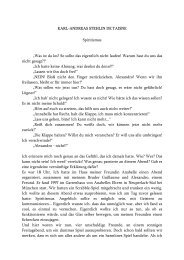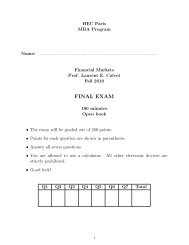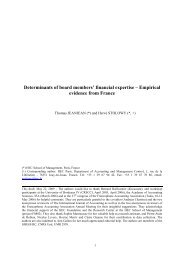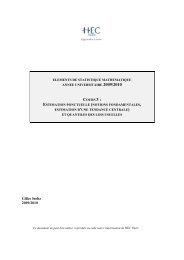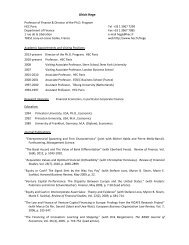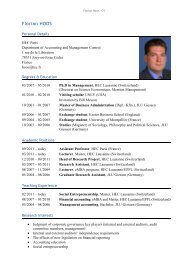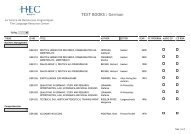Multifractality of US Dollar/Deutsche Mark Exchange Rates - Studies2
Multifractality of US Dollar/Deutsche Mark Exchange Rates - Studies2
Multifractality of US Dollar/Deutsche Mark Exchange Rates - Studies2
Create successful ePaper yourself
Turn your PDF publications into a flip-book with our unique Google optimized e-Paper software.
H is estimated by equation (6), which gives<br />
H =1.88 −1<br />
for the daily data. This leaves us with only one parameter to fit. 31 Using<br />
α0 = .589<br />
produces the parabola shown by circled stars in Figure 12. The fit with the actual data appears quite<br />
remarkable. The next section uses Monte Carlo methods to asses the variability <strong>of</strong> the spectrum.<br />
5.4 Monte Carlo Simulation<br />
The methods used for simulation are quite simple. (See MFC for other simulation examples).<br />
We approximate Fractional Brownian Motion with a Fractional Gaussian Noise, as in Section 2.3.<br />
For trading time, a finite multiplicative cascade with lognormal multipliers approximates a limit<br />
lognormal multifractal measure. The values <strong>of</strong> λ and σ 2 are recovered from H and α0 by the<br />
equations above.<br />
Several simulated processes, with corresponding log first differences, are shown in Figure 13.<br />
The results are promising, with a variety <strong>of</strong> large asymmetric price changes, apparent trends, and<br />
other characteristics typical <strong>of</strong> real data.<br />
Another goal <strong>of</strong> simulation is to test the partition function methodology. We calculated partition<br />
functions for twenty simulations with sample size identical to the data. Replication <strong>of</strong> the scaling<br />
properties <strong>of</strong> the data constitutes a joint test <strong>of</strong> the partition function methodology and simulation<br />
methods. About six or seven simulations followed a scaling law close to the data. Figure 14 shows<br />
four <strong>of</strong> these graphs. The plots are relatively straight, and vary somewhat around their predicted<br />
values. Some <strong>of</strong> the remaining simulations had nonlinear partition functions. The others had<br />
straight partition functions, but with different slope than the data.<br />
Rejection <strong>of</strong> the MMAR is thus difficult, in a problematic sense, because <strong>of</strong> apparent low<br />
power. At the same time, the results are promising. Although variability is high, the simulated<br />
partition functions tend to follow their predicted lines. Improvements in either partition function<br />
31 Joint estimation <strong>of</strong> parameters will generally improve fit, by whatever metric is chosen. This point is relatively<br />
unimportant since sequential estimation produces good results.<br />
23



